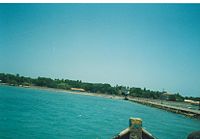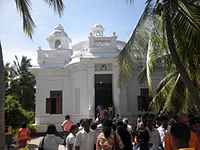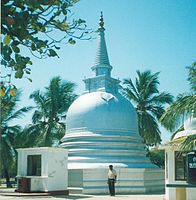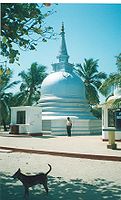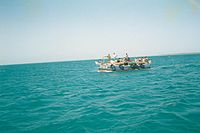- Nainativu
-
Nainativu
நயினாதீவு or නාගදීපය— Island — Coordinates: 9°36′0″N 79°46′0″E / 9.6°N 79.766667°ECoordinates: 9°36′0″N 79°46′0″E / 9.6°N 79.766667°E Country Sri Lanka Province Northern District Jaffna DS Division Islands South Nainathivu or Nainatheevu (Tamil: நயினாதீவு), (also known as Nagadipa or Nagadeepa (Sinhala: නාගදීපය)) is a small but notable island off the coast of Jaffna Peninsula in the Sri Lankan Tamil dominated Northern Province, Sri Lanka. The name of the island alludes to its aboriginal inhabitants, the Nayanair or Nāka people. It is home to the ancient Hindu shrine of Sri Nagapooshani Amman, one of the 52 Shakti Peethas, and the Buddhist shrine Naga Vihare. Historians note the island is mentioned in the ancient Tamil Sangam literature of nearby Tamil Nadu (such as Manimekalai) and ancient Buddhist legends of Sri Lanka (such as Mahavamsa). Ptolemy, a Greek cartographer, describes the Tamil territory including islands around the Jaffna peninsula as Nagadibois in the first century CE.
Contents
History
Nāka Tivu / Nāka Nadu was the name of the whole Jaffna peninsula in some historical documents. There are number of Buddhist myths associated with the interactions of people of this historical place with Buddha.[1] The two Tamil Buddhist epics of Kundalakesi and Manimekalai describe the islet of Manipallavam of Nāka Tivu/Nadu which is identified with this islet of the Jaffna peninsula. Manimekalai describes the ancient island of Manipallavam from where merchants came to obtain gems and conch shells. The Tamil language inscription of the Nainativu temple by Parâkramabâhu I of the 12th century CE states that foreign merchants must land at Kayts before entering the island, and for other ports. The Hindu temple was destroyed by the Portuguese in 1620 CE. It was restored and re-established in 1788. A portion of the inscription slab is built into the wall of the present restored temple. Nainativu temple was attacked and burnt in June 1958, and in March 1986. The Naga Deepa Buddhist Vihara was established in the 1940s by a resident monk with the help of local Tamils.[2]
Naga People
Nāka people were snake-worshippers, a Dravidian custom, and spoke Tamil based on Ptolemy's description of the Nāka people.[3][4] They also likely spoke Prakrit, a language of the school of Amaravati, Andhra Pradesh with which the early Tamils of Jaffna had strong cultural relations during the classical period. Kalittokai mentions that many Tamil Naga tribes such as Maravar, Eyinar, Oliar, Oviar, Aruvalur and Parathavar migrated to the Pandyan kingdom and started living there in the Third Tamil Sangam period 2000 years ago.[5]. The Nākas were an offshoot of the Kerala Nayar community, at that time the Chera kingdom of ancient Tamilakam. The interchangeable names Nāyar and Nāka or Naga, meaning Cobra or Serpent were applied to and self described by these snake-worshiping people from classical antiquity.[6] The word Nāka was sometimes written in early inscriptions as Nāya, as in Nāyanika - this occurs in the Nanaghat inscription of 150 BCE. Archaeological excavations and studies provide evidence of palaeolithic inhabitation in the Jaffna and Kerala region. The findings include Nāka idols and suggest that serpent worship was widely practised in the Kerala region during the megalithic period.[7][8][9][10][11]
The Nākas lived among the Yakkha, Raksha and Deva in Ceylon according to the Manimekhalai and Mahavamsa. Cobra worship, Tamil speech and Keralan cuisine extant in Jaffna Tamil culture from the classical period attests to the Nāka's Tamil heritage.
Sangam literature details how the ancient Tamil people were divided into five clans (Kudi) based on their profession during the Sangam period, where the Nāka clan, who were incharge of border security guarding the city wall and distant fortresses, inhabited the Coromandel Coast - South Tamil Nadu, East Tamil Nadu and North Sri Lanka. The name Nāka as either a corrupted version of the word Nayanar or may have been applied to this community due to their head covering being the shape of a hydra-headed cobra in reverence to their serpentine deities.[12] The rulers and society of Nāka-Tivu and Nāka-Nadu, meaning Nāka island (Tivu) or country (Nadu) are described in the Vallipuram gold plate inscriptions and the Manimekalai for many centuries.[13] H. Parker, a British historian and author of "Ancient Ceylon" considers the Nāka to be an offshoot of the Nayars of Kerala[14] Ancient Sri Lankan history book Mahavamsa mentions a dispute between two Naga kings in northern Sri Lanka.[15] The Manimekhalai and archaeological inscriptions refer to the Chola-Naka alliance and intermarriange being the progenitor of the Pallava Dynasty of Tamilakam.
Decline of Naga identity and assimilation
The Nagas are likely to have lost their identity over time, due to their loss of power and the formation of alliances with the new settlers of Sri Lanka. It is believed the original populations control over the island declined and they moved to their stronghold in the North of Sri Lanka. Nainativu being called Nayanairtheevu and Nagadeepa since ancient time explains this. The Sri Lankan Tamil people of Nainativu, are descendants of the Naga people. They continue to worship their patron Nayanair deity within the sanctum sanctorum of the Nainativu Sri Nagapooshani Amman Temple. Historical records show that this temple was established by the Kerala Nairs who travelled between the Chera Kingdom and the early Jaffna Kingdom. The temple continues to be a major pilgrimage location for Kerala Nairs, neighbouring Sri Lankan Tamils, and some Indian Tamils of Southern coastal regions of Tamil Nadu despite the decline of the Naga identity.
There are many Naga temples in India and many Hindu families are descended from Nagavanshis. The Nairs, Nayaks, Bunts are all snake worshipping people. Nair families have sarpa kavus in their Theravad (ancestral house), the same applies for Bunts and most of the royal families of Kerala and Tulunadu.
Demography
The population of the island is approximately 2,500 Sri Lankan Tamils and about 250 Muslims Many Tamils of Nainativu origin, live in various cities and towns of India, Europe, Australia, and North America as part of the Sri Lankan Tamil diaspora.[2]
Gallery
Nainativu Gallery Nagapooshani Amman temple, NainativuNagapooshani Amman temple - view from the seaNagadipa temple, NainativuNainativu Naha ViharaNainativu Naha ViharaNainativu boat serviceSee also
Other places of Hindu and Buddhist jointveneration in Sri Lanka.
- Adams Peak
- Kataragama temple
- Munneswaram temple
- Nallur (Jaffna)
References
- ^ Malalasekera, G.P. (2003). Dictionary of Pali Proper Names: Pali-English. Asian Educational Services. p. 42. ISBN 8120618238.
- ^ a b Meeadhu, Kalabooshanam (13 June 2008). "Nainativu Nagapooshani Chariot festival". http://www.dailynews.lk/2008/06/13/fea05.asp. Retrieved 18 January 2011.
- ^ Laura Smid (2003). South Asian folklore: an encyclopedia : Afghanistan, Bangladesh, India, Pakistan, Sri Lanka. Great Britain: Routledge. 429.
- ^ Chelvadurai Manogaran (1987). Ethnic conflict and reconciliation in Sri Lanka . United States of America: University of Hawaii Press. 21.
- ^ The Tamils Eighteen Hundred Years Ago By V. Kanakasabhai
- ^ WWW Virtual Library Sri Lanka. (2009). The original inhabitants of Lanka: Yakkas & Nagas. Available: http://www.lankalibrary.com/cul/yakkas.htm. Last accessed 07 March 2010.
- ^ http://keraladotpark.com/pdf/Archacological%20wonders.pdf A research paper from archaeologist Dr. P. Rajendran showing evidence of paleolithic age human inhabitation in Kerala. This includes the pictures of serpent idols made of clay and metal which belong to the mesolithic age.
- ^ Department of Archaeology, Kerala University confirms paleolithic age findings in Kerala
- ^ General article for palaeolithic age findings in Kerala
- ^ A very detailed article including palaeolithic age in Kerala
- ^ "Anthropological museum to have new additions". The Hindu Newspaper (Kerala). 27 December 2010. http://www.hindu.com/2010/12/27/stories/2010122755780500.htm. Retrieved 2011-05-03.
- ^ Srilankanreference. (2009). Sri Lanka - Yakksha and Naga Times. Available: http://www.info.lk/srilanka/srilankahistory/yaksa_naga.htm. Last accessed 07 March 2010.
- ^ Peter Shalk. SERENDIPITY - ISSUE 02 - THE VALLIPURAM BUDDHA IMAGE - AGAIN
- ^ H. Parker (1909). Ancient Ceylon. New Dehli: Asian Educational Services. 7.
- ^ http://www.lankalibrary.com/heritage/naga.htm
Categories:- Jaffna District
- Islands of Sri Lanka
- Tamil Buddhism
Wikimedia Foundation. 2010.



